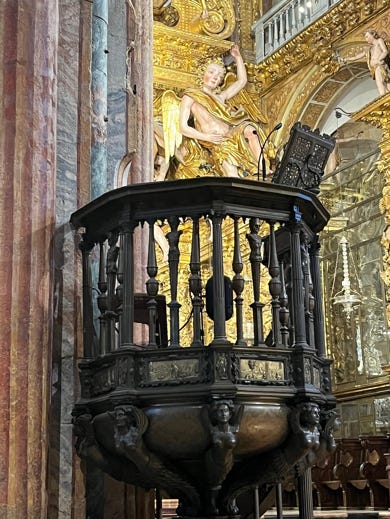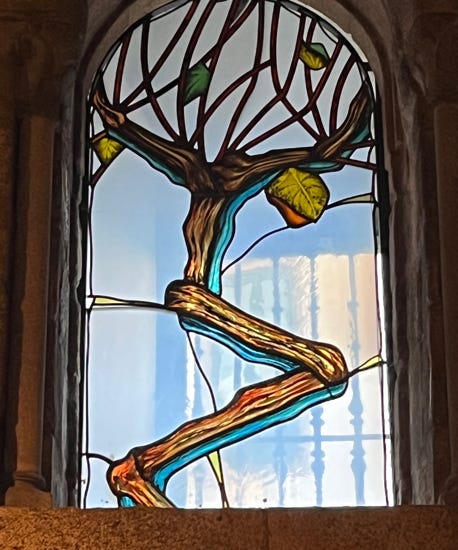A Pilgrim’s Progress, Part I
Deliverance, Without a Promised Land
Preface: A Californian Dreamin’
“Last night I had the strangest dream, I’d never dreamed before,
I dreamed the word had all agreed to put an end to war.”
Recently, the current occupant of the White House issued the following Executive Order:
“On August 7, 1789, 236 years ago, President George Washington signed into law a bill establishing the United States Department of War to oversee the operation and maintenance of military and naval affairs. … The Founders chose this name to signal our strength and resolve to the world. The name “Department of War,” more than the current “Department of Defense,” ensures peace through strength, as it demonstrates our ability and willingness to fight and win wars on behalf of our Nation at a moment’s notice, not just to defend. This name sharpens the Department’s focus on our own national interest and our adversaries’ focus on our willingness and availability to wage war to secure what is ours. I have therefore determined that this Department should once again be known as the Department of War and the Secretary should be known as the Secretary of War.”
A Pilgrim’s Path: Which Direction?
“In 1492, Columbus sailed the ocean blue …”
On a recent cycling trip which Germaine and I undertook in northwest Spain and the Portuguese coastline the route took us through numerous quaint villages and many miles of vineyards and mountainous landscapes. Along the way, the guides recounted the ancient history of the two great former empires that had once navigated the world in conquests now relegated to the dustbin of history.
The route began in Santiago, Spain; in front of the Cathedral of Santiago de Compostela, dedicated to St. James. For over a thousand years, pilgrims have travelled the Camino de Santiago for a variety of reasons to this destination. But the towering cathedral itself is a religious monument to part of that now ancient glory; when conquistadors had once discovered “new worlds” and claimed them as their own, in the name of their own state and organized religion.
Inside the religious shrine, one could not help but be struck by the ornate – if not ostentatious – depiction of a savior figure, surrounded by angels and archangels heralding its message.
However, the cycling route for the next eight days led us in the opposite direction. Along the way we’d pass numerous pilgrims, with their walking sticks and backpacks. Being one to never pass up a good metaphorical interpretation, I couldn’t help but wonder who was going in the wrong direction …
Deliverance, Without a Promised Land
“The falling leaves drift by my window …” once again …
Waging war, in order to “secure what is ours,” might aptly describe the cyclical story that comprises human history. Empires rise and fall, come and go. The repetitive cycle of human history we’re still experiencing on a daily basis perpetuates the same plotline; consisting of “turf wars” and “land grabbing;” resulting in tragic conflicts of retaliatory violence. The Israeli-Palestinian conflict in Gaza, and Russia’s invasion in Ukraine are only the latest examples of indisputable genocide. The resulting death, devastation and displacement will only fuel another generation of fighters claiming to secure a “lasting peace.”
But lest we forget, the biblical tradition also includes the notion of a so-called “promised land” for wandering sojourners without a place to call “home.” For example, in exchange for allegiance and obedience, Moses tells the Israelites their god will bequeath to them just such a place (Deut. 30:15-20).
But in the gospel tradition, we are also reminded that Jesus, the Galilean peasant sage, was portrayed as an itinerant, “with no place to lay his head.” (Mt. 8:20, Lk. 9:58). Still, he beckons anyone who would be his disciple to come, follow him. But to where? And, if – as the saying goes – home is where the heart is, what remains at the heart of his life and teaching that might still promise another place to dwell, now and always?
In this story, I’ll return to where the last chapter of my own last pilgrimage began, at the Cathedral of Santiago de Compostela.
While wandering past the crowds of sightseers and a small gathering of worshippers who’d gathered for mass, I stole away to a secluded side chapel that was closed and empty. Peering down the name of the chapel there was a very simple stained-glass window with the depiction of what first appeared to be a dead and barren tree.
Then, looking more closely, of course, one could discern it was the image of crucified figure with its head hung low. There was a single green leaf emerging from what was once – and might be again – a tree of life.
Translation: Despite the rise and fall of empires and the destructive messages they proclaim of hollow victory and bitter, decadent defeat, the “living words, teachings and life example” of a wandering itinerant sage from Galilee still lingers and remains like that one green leaf.
© 2025 by John William Bennison, Rel.D. All rights reserved. This article should only be used or reproduced with proper credit. To read more commentaries by John Bennison from the perspective of a Christian progressive go to the Archives.







